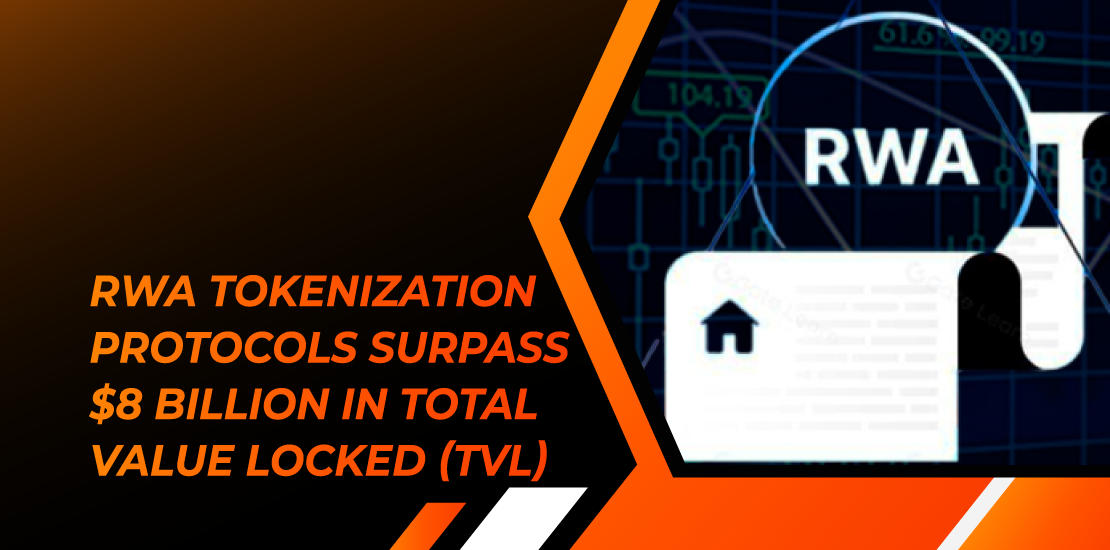- May 2, 2024
- Posted by: [email protected]
- Category:


The rapid rise of real-world asset (RWA) tokenization protocols in recent times has captivated the attention of market observers as these innovative platforms continue to rewrite the rules of traditional finance. This surge in growth has culminated in a monumental milestone, with the total value locked (TVL) in RWA protocols eclipsing the $8 billion mark by the close of April, according to blockchain analytics firm Messari.
This unprecedented rise of the RWA sector can be attributed to a number of major factors, the most notable of which is the growing desire for high-yield, debt-based investment possibilities in today’s financial landscape. Investors seeking diversification and attractive returns have increasingly turned to RWA protocols, drawn by the promise of unlocking value from real-world assets through blockchain technology.
Messari’s analysis sheds light on the remarkable resurgence experienced by RWA protocols, fueled by a confluence of market dynamics and investor preferences. The surge in TVL represents not only a quantitative leap but also a qualitative shift in the perception of decentralized finance (DeFi) as a viable alternative to traditional financial instruments.
The $8 billion TVL amount excludes prominent fiat-backed stablecoins such as Tether and USD Coin, highlighting the RWA sector’s significance across several asset classes. RWA protocols have pervaded various parts of the market, from carry trade protocols to yield-bearing stablecoins and commodities to securities and real estate tokenization, unlocking value and liquidity that were previously unavailable to ordinary and institutional investors alike.
TVL’s exponential growth, up over 60% since February, demonstrates how quickly the RWA sector is moving. While DeFiLlama reports a slightly lower TVL figure of $6 billion, the sheer magnitude of growth—700% since the beginning of 2023—underscores the sector’s resilience and adaptability in the face of market fluctuations and regulatory uncertainties.
Moreover, alongside the surge in TVL, RWA protocols have witnessed a surge in active users, signifying a broader adoption trend across retail and institutional segments. Data from Dune Analytics reveals a groundswell of interest among smaller retail investors, highlighting the democratizing effect of RWA protocols in democratizing access to lucrative investment opportunities.
Driving this growth are pioneering protocols such as Toucan and KlimaDAO in the digital carbon market space, along with Propy in real estate tokenization, which have emerged as trailblazers in their respective domains. These platforms have not only attracted a growing user base but have also catalyzed innovation and experimentation within the broader DeFi ecosystem.
Furthermore, the expanding tokenized treasury market has emerged as a key driver of growth within the RWA sector, offering investors an avenue to hedge against inflation and generate attractive yields in an environment of economic uncertainty. Platforms like RWA.xyz have reported record-locking of $1.29 billion in tokenized U.S. treasuries and bonds, signaling growing investor confidence in blockchain-based financial instruments.
Similarly, the recent success of BlackRock’s Ethereum-based Institutional Digital Liquidity Fund (BUIDL) and the Franklin OnChain U.S. Government Money Fund (FOBXX) has underscored the growing institutional interest in tokenized assets. BUIDL, in particular, has achieved the distinction of becoming the world’s largest tokenized treasury fund, marking a significant milestone in the mainstream adoption of blockchain-based financial products.
The expansion of asset tokenization beyond public blockchains to include private blockchains has widened the scope of investment opportunities. From Franklin Templeton’s U.S. Government Money Fund expanding to Polygon to initiatives like Backed Finance’s tokenized short-term U.S. Treasury bond ETF and UBS Asset Management’s deployment of a tokenized money market fund on the Ethereum blockchain, the convergence of traditional finance and blockchain technology is accelerating at an unprecedented pace.
DigiFT, a Singapore-based fintech business, made headlines in March when it launched its US Treasury bill depository receipt (DR) tokens, which allow investors to own a fraction of the underlying US Treasury bills. This innovative offering exemplifies the transformative potential of blockchain technology in democratizing access to traditional financial markets, opening new avenues for retail and institutional investors to participate in the global economy.
The surge in RWA tokenization protocols and the unprecedented growth in TVL represent a seismic shift in the financial landscape, with blockchain technology emerging as a disruptive force capable of redefining traditional finance. As the RWA sector continues to evolve and mature, it holds the promise of unlocking new levels of liquidity, transparency, and efficiency in capital markets, ushering in a new era of financial inclusion and democratization.



